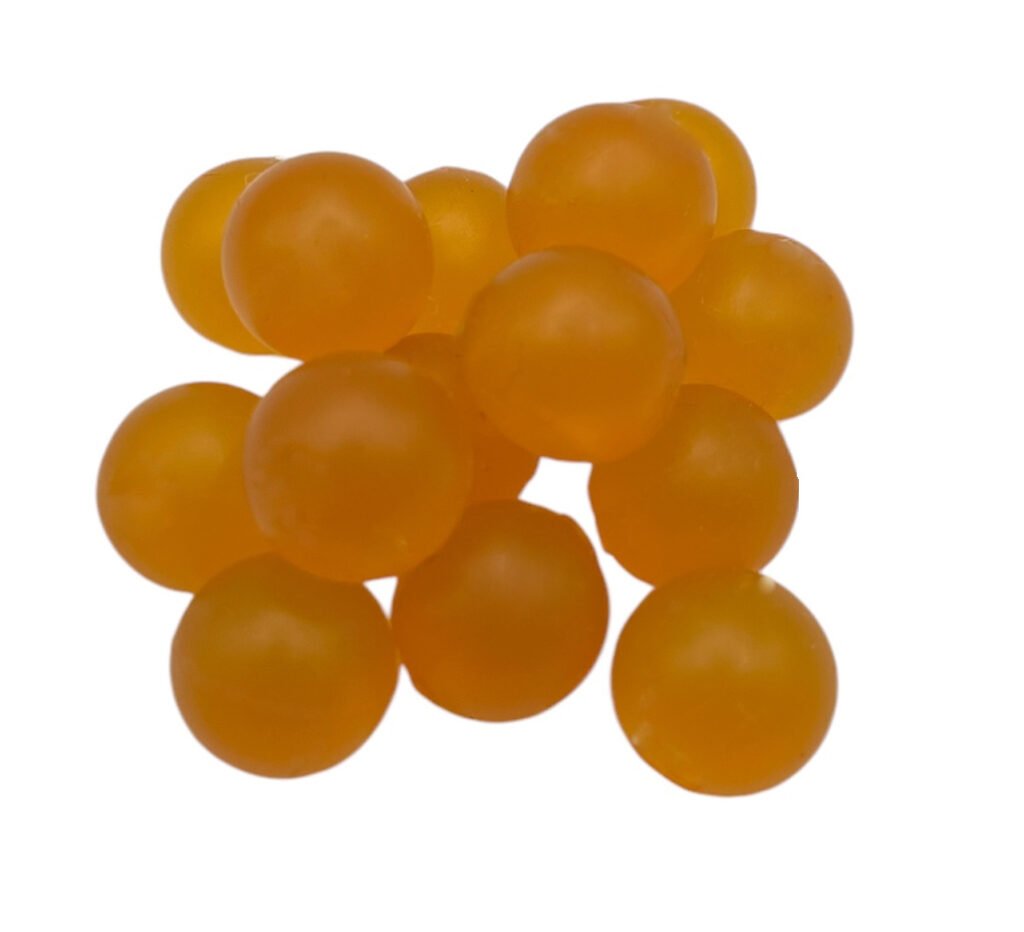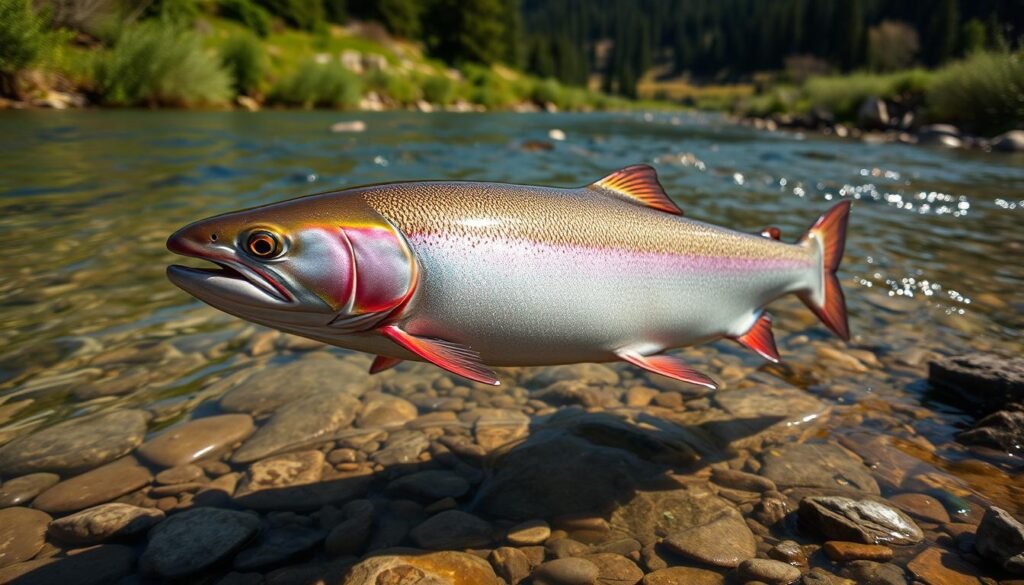A Guide to the Fascinating Types of Trout in Canada
Canada is home to many types of trout. Imagine standing at a Canadian lake at dawn. The sunlight dances on the water, and you feel the quiet thrill of trout swimming beneath. This moment is more than fishing; it’s a connection to Canada’s wild places. We’ve created this guide to explore Canada’s trout species, blending passion with precision.
Canada’s waters are home to many trout species. Lake trout thrive in cold lakes from the Atlantic to the Rockies1. Rainbow trout are known for their energetic fights and vibrant colours2. Each species has its own story of adaptation, from brook trout’s speckled patterns to steelhead’s powerful runs.
We designed BeadnFloat’s Soft Beads to mirror trout’s natural hues. Sizes range from 6mm to 19mm. Whether you’re fishing near the Great Lakes or Alberta’s streams, our beads add lifelike appeal to your gear.
Every detail here comes from decades of research and real-world experiences. We share science and stories, from lake trout’s 20-year lifespans1 to rainbow trout’s global impact2. Let’s explore these waters together, honoring both the fish and their habitats.
Understanding Canada’s Trout Habitats
Canada’s freshwater areas are home to many brown trout and brook trout. Each type lives in different places3.
Our Personal Encounters with Trout Ecosystems
We saw brown trout in shaded streams. The plants around kept the water cool3. Brook trout liked clear, fast water with places to hide3.
Riparian zones help keep the water cool by blocking sunlight and stopping sediment4. Water that’s too warm, over 18°C, makes it hard for trout to eat and survive3.
Highlighting the Vibrant Colours: A Nod to BeadnFloat’s Soft Beads
BeadnFloat’s Soft Beads look like the colours of trout. They have shades that match brook and brown trout5. Here’s a look at how bead colours match trout features:
These beads help anglers match the colors trout see in their homes5.

Exploring the Diverse types of trout
Canada’s waterways are home to many trout species. Each one is shaped by its environment. For example, cutthroat trout and lake trout show how different places can change their looks and ways of life.
These fish are not just different in appearance. They also live in specific places that help them survive. This shows how nature shapes each species in its own way.
| Species | Habitat | Average Size | Key Traits |
|---|---|---|---|
| Cutthroat Trout | Cold mountain streams, rivers | 12–24 inches | Distinctive jaw markings; sensitive to water temperature changes |
| Lake Trout | Deep, cold lakes | 20–40 inches | Slow-growing; thrive in low-light depths |
Changes in the environment affect these fish. Cutthroat trout need clear, oxygen-rich waters. Lake trout, on the other hand, live in darker, colder areas.
Anglers find cutthroat trout to be very cautious in streams. This is because of their history. Lake trout, with their slow growth, can live in deeper waters, as studies show.
“Their survival depends on habitat preservation—each species tells a story of adaptation.”
Our research on trout behavior has been fascinating. Like how BeadnFloat makes Soft Beads, each trout has unique traits. Their diets and migration patterns show how healthy an ecosystem is. Knowing these differences helps protect Canada’s waterways.
Identifying Iconic Trout Species
Canada’s waterways are home to many trout species, each with its own special features. Whether you’re fishing in British Columbia or Quebec, knowing these differences can make your trip unforgettable.
Insights on Rainbow and Brown Trout
Rainbow trout have olive-green backs with pink stripes. Brown trout have copper colors with dark spots. Both love cold, clear streams. Our guides suggest using lures that match their colours.
Spotting Brook, Cutthroat, and Lake Trout Differences
- Brook trout have crimson fins and worm-like patterns.
- Cutthroat trout have a yellow slash under the jaw.
- Lake trout are bigger, with forked tails and silver scales.
Unveiling the Rarity of Steelhead Trout and Golden Trout

Steelhead trout, rainbow trout that go to sea, need protection in BC’s rivers. Golden trout, rare in Alberta’s high lakes, are golden with crimson fins. Seeing them is a big deal for anglers. Our field journals say, “Every hue tells a story”—just like BeadnFloat’s lures that match their beauty.
“Their colours aren’t just for beauty; they’re survival tools.” – Canadian Wildlife Federation study, 2023
Seasonal Trends and Conservation Efforts
Anglers and conservationists work together to protect Canada’s types of trout species. Spring is when rainbow trout spawn. Fall is when lake trout move to deeper waters. These changes guide fishing and habitat plans.
Seasonal Shifts in Trout Behavior
- Rainbow trout spawn in spring, seeking gravel beds in clear streams
- Brook trout migrate to shallower areas in summer
- Winter slows feeding activity across all species
Conservation in Action
“Protecting trout habitats ensures biodiversity for future generations.” — Canadian Wildlife Federation, 2023
We work with fisheries to promote catch-and-release fishing and habitat restoration. Our Soft Beads are made with non-toxic materials. This shows our dedication to protecting these ecosystems.
Tracking seasonal data helps us keep an eye on population health. By teaming up with conservation groups, every purchase helps protect these iconic species. Let’s keep finding a balance between enjoying nature and taking care of it.
Conclusion
Canada’s waters are home to many types of trout, each unique. Rainbow trout, for example, can grow up to 18 kg in British Columbia6. Brook trout stand out with their olive-green bodies and red spots6.
Lake trout in Alberta’s deep lakes can grow over 20 kg6. Cutthroat trout thrive in British Columbia’s rivers6. These fish are more than just numbers; they tell stories of survival and adaptation.
BeadnFloat’s Soft Beads show how innovation meets conservation7. They help with catch-and-release fishing. As caretakers of our waters, we encourage anglers to respect these fish and the environment.
Let’s make sure future generations can enjoy these trout as much as we do. Every time we fish, we help protect Canada’s water heritage. Together, we can keep this balance of passion and responsibility.
Source Links
- https://www.dfo-mpo.gc.ca/species-especes/profiles-profils/lake-trout-touladi-eng.html
- https://www.dfo-mpo.gc.ca/aquaculture/sector-secteur/species-especes/trout-truite-eng.htm
- https://www.troutheadwaters.com/cold-clear-and-clean-what-a-trout-wants/
- https://tucanada.org/cooling-streams-2/
- https://midcurrent.com/books/the-requirements-of-stream-trout/
- https://thecanadianencyclopedia.ca/en/article/trout
- https://www.beadnfloat.com/soft-beads




Add comment